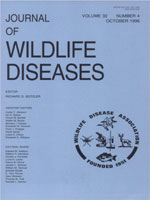In August 1994, cryptosporidiosis was diagnosed in a diarrheic fawn from a captive white-tailed deer (Odocoileus virginianus) herd maintained for research purposes at The University of Georgia's Warnell School of Forest Resources in Athens, Georgia (USA). From June through August 1995, 11 captive female white-tailed deer were housed in individual barn stalls where they gave birth to 18 fawns. Feces collected at 2 or 3 day intervals from the 18 neonatal fawns for at least 21 days and from 11 adult females once from 1 to 30 days before fawns were born and on three to 12 occasions after their birth were examined for oocysts of Cryptosporidium spp. Feces from all animals appeared normal throughout the period of examination. Oocysts morphologically indistinguishable from those of Cryptosporidium parvum were detected intermittently in the feces of one adult female from 1 to 25 days after parturition and in the feces of her fawn from 11 to 22 days of age. Oocysts also were detected intermittently in feces from twin fawns from 9 to 20 days of age, but not from their mother. Oocysts from deer were infectious for neonatal mice as determined histologically, and for calves as determined by clinical signs and excretion of oocysts.
How to translate text using browser tools
1 October 1996
SPONTANEOUS CRYPTOSPORIDIOSIS IN CAPTIVE WHITE-TAILED DEER (ODOCOILEUS VIRGINIANUS)
Ronald Fayer,
John R. Fischer,
Christopher T. Sewell,
Darrell M. Kavanaugh,
David A. Osborn

Journal of Wildlife Diseases
Vol. 32 • No. 4
October 1996
Vol. 32 • No. 4
October 1996
captive deer
Cryptosporidiosis
Cryptosporidium parvum
Odocoileus virginianus
white-tailed deer




